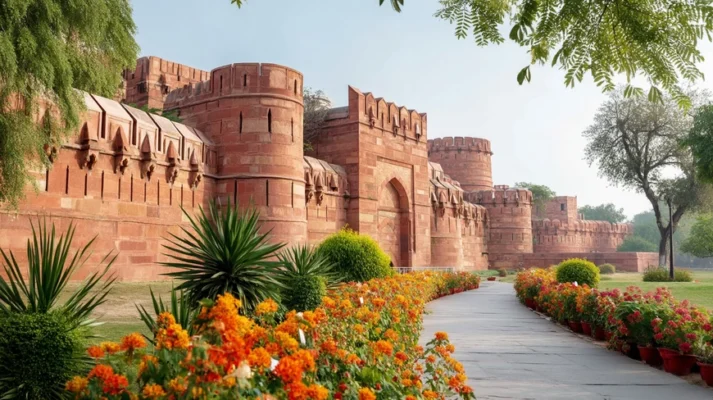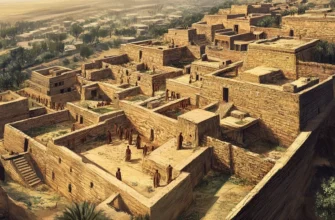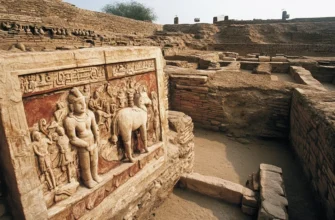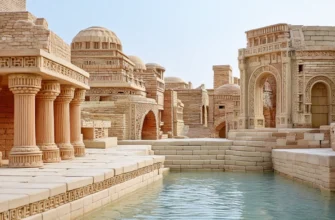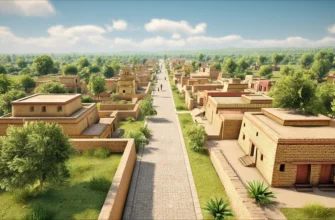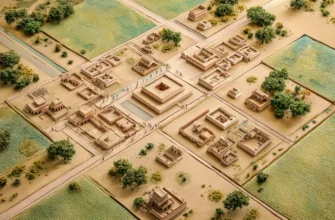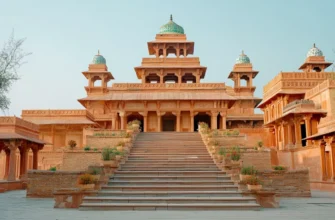Lal Qila, or the Red Fort of Agra, is one of the greatest fortresses in India, located in the city of Agra, not far from the world-famous Taj Mahal. It was built in the 16th century by Emperor Akbar the Great from red sandstone and served as the main residence of the Mughal rulers.
The fortress has powerful walls 2.5 km long, numerous palaces, mosques, and reception halls, including the Diwan-i-Aam (hall for public audiences) and Diwan-i-Khas (hall for private meetings). Inside are exquisite structures such as the Pearl Mosque and the palace of Shah Jahan, who was later imprisoned in the fort by his own son.
Today, Lal Qila is an important tourist attraction and is listed as a UNESCO World Heritage Site. It symbolizes the power, grandeur, and rich history of India, attracting thousands of visitors from all over the world.
History of Lal Qila
Lal Qila, or the Red Fort of Agra, has a rich and magnificent history dating back to the 16th century. The fort became a symbol of the power of the Great Mughals and played a key role in the political and military events of India.
Construction and reign of Akbar
The fort was built by order of the Mughal emperor Akbar the Great between 1565 and 1573.
He chose the city of Agra as his capital and built a fortress out of red sandstone, fortifying it with massive walls. Lal Qila served not only as a defensive structure but also as the royal residence. At that time, Agra was a strategically important city and the de facto capital of the empire.
The fortress was built to strengthen the city’s defenses and create a secure residence for the rulers.
Akbar wanted to make Lal Qila the main administrative and military center of the empire. He chose a site on the banks of the Yamuna River, which provided natural protection and easy access to waterways.
Although the exact names of the fortress’s architects are unknown, the construction was supervised by court architects under the direct supervision of Emperor Akbar. The fortress was built mainly of red sandstone, which gives it its characteristic color.
Subsequent rulers of the Mughal Empire made their own changes to the complex:
Jahangir added new palaces and gardens, making the fort more luxurious.
Shah Jahan partially rebuilt Lal Qila, adding marble structures and elegant decorative elements. It was during his reign that such architectural masterpieces as the Diwan-i-Aam, Diwan-i-Khas, and Pearl Mosque appeared.
Aurangzeb completed some of the defensive structures and built additional fortifications.
Lal Qila not only became a symbol of the power of the Great Mughals, but also went down in history as one of the most important architectural monuments in India.
Lal Qila during the Mughal Empire
Lal Qila played a key role in the political and military life of the Mughal Empire. It served as the royal residence, administrative center, and strategic defensive structure for several centuries.
Use of the fortress in different periods
During the reign of Akbar (1556–1605)
Lal Qila became the main citadel of the empire. It housed the administration, treasury, and army. The fortress was a venue for ceremonial receptions and military councils.
During the reign of Jahangir (1605–1627)
The fortress took on a more luxurious appearance: new gardens, pavilions, and palaces appeared. Jahangir used Lal Qila to receive foreign ambassadors and conduct diplomatic negotiations.
During the reign of Shah Jahan (1628–1658)
the fortress reached the peak of its grandeur. Shah Jahan added marble palaces, the Diwan-i-Aam (hall for public audiences) and the Diwan-i-Khas (hall for private receptions).
During the reign of Aurangzeb (1658–1707)
Lal Qila became an important military site, as Aurangzeb focused on waging wars. He strengthened the fortifications and used the fortress as a base for his military campaigns.
Role in political and military events
Lal Qila was a symbol of imperial power and the coronation site of Mughal emperors.
Key decisions that determined the fate of the empire were made here.
The fortress withstood numerous sieges and attacks, including during the wars between the Mughals, Marathas, and Afghan invaders.
In the 18th century, Lal Qila gradually lost its importance as the Mughal Empire began to weaken. Eventually, the fortress fell under British control in 1803.
Today, Lal Qila remains one of India’s most significant historical monuments, preserving the magnificent heritage of the Mughal era within its walls.
The colonial period and Indian independence
In the 18th century, after the decline of the Mughal Empire, Lal Qila changed hands several times.
In 1761, it was captured by the Afghans under the leadership of Ahmed Shah Durrani, and later by the Marathas. In 1803, the fortress came under the control of the British East India Company after the defeat of the Marathas in the Second Anglo-Maratha War.
The British used Lal Qila as a military base. In 1857, during the First War of Independence (the Sepoy Rebellion), the fortress became a key defensive point for Indian rebels. After suppressing the uprising, the British arrested the last Mughal emperor, Bahadur Shah II, and sent him into exile.
During the colonial period, many of Lal Qila’s historic buildings were destroyed or converted into barracks by the British.
After India gained independence in 1947, Lal Qila became a national symbol of the country. Although much of the fort was damaged during the colonial era, the Indian government began extensive restoration work.
In 1983, UNESCO added Lal Qila to the World Heritage List, which contributed to the strengthening of measures for its protection. Today, the fort is one of the most popular tourist attractions in India, and its walls preserve the memory of the magnificent history of the Mughal Empire and the struggle for independence.
Architectural features
Lal Qila in Agra is a masterpiece of Mughal architecture, combining elements of Persian, Indian, and Islamic building traditions. The fortress has a unique combination of defensive structures and elegant palace complexes, making it one of the greatest citadels in India.
Main materials and style
The main building material is red sandstone, which gives the fort its characteristic color.
During the reign of Shah Jahan, some parts of Lal Qila were rebuilt in white marble, adding sophistication to the palace buildings.
The architectural style combines massive defensive walls with decorative arches, mosaics, calligraphic inscriptions, and garden ensembles.
Fortifications
Massive walls 2.5 km long and up to 21 meters high created a powerful defensive line.
The fortress had four main gates, the most famous of which are the Delhi Gate and the Amr Singh Gate.
The moat around the fortress walls was once filled with water for additional protection.
Notable structures inside the fortress
Divan-i-Aam – a hall for public audiences, where emperors received their subjects and considered complaints.
Divan-i-Has is a hall for private meetings, decorated with white marble and inlaid with semi-precious stones.
The Pearl Mosque (Moti Masjid) is a small but elegant mosque built by Shah Jahan for his courtiers.
Shah Jahan’s palaces are a series of luxurious marble residences, including the Khass Mahal and Musamman Burj, from where the imprisoned emperor could see the Taj Mahal.
Lal Qila is impressive for its scale, thoughtful architecture, and harmonious combination of defensive and aesthetic elements. Today, it is a symbol of India’s rich historical and cultural heritage.
Notable structures inside the fort
Lal Qila in Agra is not just a fortress, but a whole complex of magnificent buildings that combine defensive, administrative, and palatial functions. Inside the fortress, numerous palaces, mosques, reception halls, and other notable architectural monuments have been preserved.
Diwan-i-Aam (Hall for public audiences)
This is a spacious hall where the emperor received his subjects and considered their complaints. The building has an open design with colonnades that provided ventilation. The emperor’s throne was located on a raised platform, and behind it was an ornate marble screen.
Divan-i-Has (Hall for private audiences)
A luxurious hall designed for meetings between the emperor and his close ministers and foreign ambassadors. The building is constructed of white marble and decorated with precious stones. It was here that the famous Peacock Throne, inlaid with gold and precious stones, was located.
Khas Mahal (Private Palace of the Emperor)
This is the marble palace where the emperor lived. It consists of several rooms decorated with carvings, niches, and mosaic ornaments. Inside, fountains and water channels have been preserved, which provided coolness on hot days.
Musamman Burj (Shah Jahan’s Observation Tower)
This is an octagonal tower overlooking the Yamuna River and the Taj Mahal. It was here that Emperor Shah Jahan spent the last years of his life under house arrest, only able to admire the mausoleum of his beloved wife Mumtaz Mahal from afar.
Moti Masjid (Pearl Mosque)
An elegant mosque built by Shah Jahan for his courtiers. It is made entirely of white marble, giving it an elegant and peaceful appearance.
Shish Mahal (Palace of Mirrors)
A luxurious hall with walls and ceilings covered with countless small mirrors. Even a small light at night created the effect of a starry sky.
Anguri Bagh (Vine Garden)
This is an inner garden with symmetrical flower beds and fountains, which was used as a place of rest for the emperor and his family.
These remarkable structures of Lal Qila reflect the richness and sophistication of Mughal architecture, combining practicality with luxury.
Today, they are major attractions that draw tourists from all over the world.
Lal Qila today
Today, Lal Qila is one of India’s most visited historical monuments and an important tourist attraction. It attracts thousands of tourists from all over the world thanks to its architectural grandeur, rich history, and cultural significance. The fort was listed as a UNESCO World Heritage Site in 1983, further emphasizing its importance as a cultural heritage site.
Historical tours — Visitors can take part in organized tours where they learn about the history of the fort, its architecture, and important events that took place in Lal Qila.
Museums and exhibitions — Inside the fortress, there are several museums displaying ancient artifacts, maps, weapons, and other historical items related to the Mughal era and the colonial period.
Architectural masterpieces — Tourists can see famous buildings such as Diwan-i-Aam, Diwan-i-Khas, Moti Masjid, and Khass Mahal, as well as enjoy luxurious palaces, gardens, and fountains.
Lal Qila is equipped with modern infrastructure for the convenience of visitors, including souvenir shops, restaurants, and recreation areas.
For tourists who want to learn more about the history of the fort, audio guides are available in various languages.
Organized light shows and evening programs allow visitors to experience the atmosphere of bygone eras.
Lal Qila is the venue for important national holidays, including India’s Independence Day (August 15), when the Prime Minister of India traditionally raises the national flag on the grounds of the fort. This is a momentous event that attracts thousands of visitors and media attention.
Today, Lal Qila is an important cultural and tourist center that not only preserves its history but also actively interacts with modern visitors, maintaining a link between the past and the present.
Conclusion
Lal Qila in Agra is not only an architectural marvel but also an important symbol of Indian history and culture. Built during the Mughal Empire, it has witnessed numerous historical events, from the coronations of emperors to major political changes that shaped the fate of an entire nation.
As one of the finest examples of Mughal architecture, Lal Qila impresses with its combination of functionality and luxury, blending defensive elements with the aesthetic and cultural achievements of its time.
Lal Qila is also an important repository of historical memory, allowing future generations not only to learn about the grandeur of the Mughal era, but also to understand India’s struggle for independence and its colonial past. Through the preservation and restoration of this fortress, India is not only protecting part of its cultural heritage, but also passing on this wealth to future generations. Lal Qila is a living witness that reminds us of the importance of history, culture, and national identity for the future development of the country.
Thus, Lal Qila is not only a tourist attraction but also an important center for the preservation and promotion of Indian history, combining architectural, cultural, and historical aspects while preserving its heritage for future generations.
